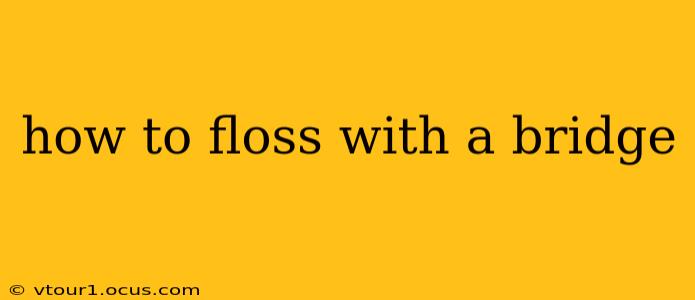Dental bridges are a fantastic solution for replacing missing teeth, restoring your smile, and maintaining oral health. However, flossing with a bridge requires a slightly different technique than flossing natural teeth. Improper flossing can lead to plaque buildup and gum disease, so mastering the correct method is crucial. This guide will walk you through the process, answering common questions along the way.
What's the Best Way to Floss Around a Dental Bridge?
The key to effective flossing with a bridge is using the right tools and techniques to thoroughly clean beneath and around the bridge. You'll need dental floss threaders, super floss, or a water flosser.
-
Dental Floss Threaders: These are small, rigid pieces of plastic with a loop at the end designed to easily slip under the bridge. Simply thread the floss through the threader, then carefully guide it under the bridge. Once under the bridge, remove the threader and gently floss around each abutment tooth (the teeth supporting the bridge).
-
Super Floss: This specialized floss features three distinct sections: a stiff end for guiding under the bridge, a spongy section for cleaning around the abutments, and regular floss for cleaning the rest of your teeth.
-
Water Flosser (Oral Irrigator): A water flosser uses pressurized water to clean between teeth and under the bridge. This can be an excellent addition to, or even a replacement for, traditional flossing for some individuals, particularly those with dexterity challenges. Always follow the manufacturer’s instructions.
Remember, gentle but firm movements are essential to avoid damaging your gums or the bridge itself.
Can I Use Regular Floss with a Dental Bridge?
While you can try to use regular floss, it's generally not recommended. The challenge lies in getting the floss under the bridge without snagging it or damaging the gums. Regular floss lacks the stiffness and specialized design of threaders or super floss, making it difficult to navigate the tight spaces.
How Often Should I Floss with a Dental Bridge?
Just like with natural teeth, you should floss with a dental bridge at least once a day, ideally before bedtime. Consistent flossing helps prevent plaque buildup, which can lead to gum disease, cavities, and even damage to the bridge itself.
What if I'm Having Trouble Flossing Under My Bridge?
If you're having difficulty flossing under your bridge, don't hesitate to contact your dentist or periodontist. They can show you the proper technique and offer additional advice or tools. They may also recommend professional cleaning to remove any stubborn plaque buildup.
Does Flossing Damage Dental Bridges?
Flossing won't damage a well-fitted dental bridge if done correctly. However, aggressive flossing or using inappropriate techniques can irritate the gums or damage the bridge. Gentle, careful movements are key.
What Happens If I Don't Floss My Dental Bridge?
Neglecting to floss your dental bridge can lead to several problems:
- Gum disease (gingivitis and periodontitis): Plaque buildup around the abutment teeth can inflame the gums, leading to bleeding, swelling, and potentially bone loss.
- Cavities: Plaque can lead to cavities, both on the abutment teeth and possibly under the bridge itself.
- Bridge failure: Severe gum disease can weaken the support for the bridge, leading to its eventual failure.
- Bad breath (halitosis): Trapped food particles and plaque contribute to unpleasant breath.
Is it Necessary to Floss Under a Dental Bridge?
Yes, it's absolutely crucial to floss under your dental bridge. The area beneath the bridge is particularly prone to plaque accumulation, making it vital to maintain a rigorous cleaning routine. Failure to do so can lead to serious oral health complications.
By following these tips and consistently practicing proper flossing techniques, you can maintain optimal oral health and prolong the lifespan of your dental bridge. Remember, regular dental checkups are also essential to monitor the health of your bridge and gums.
